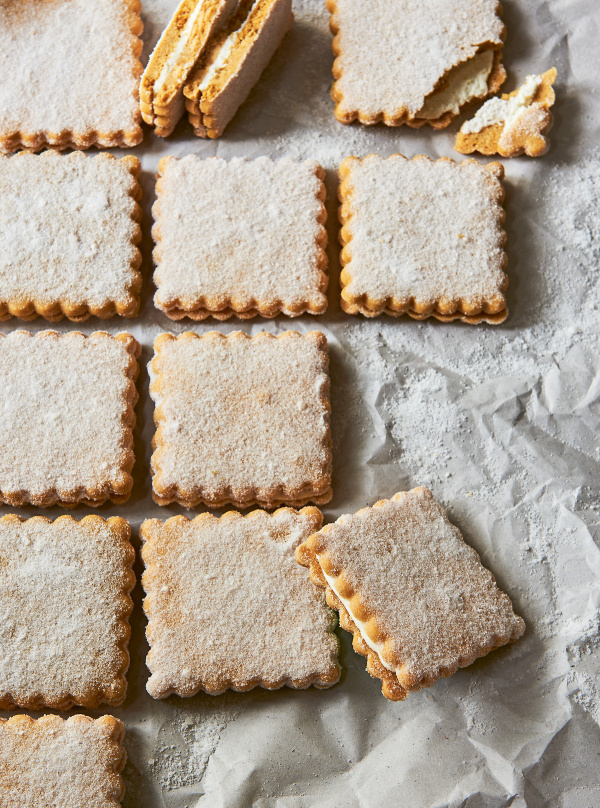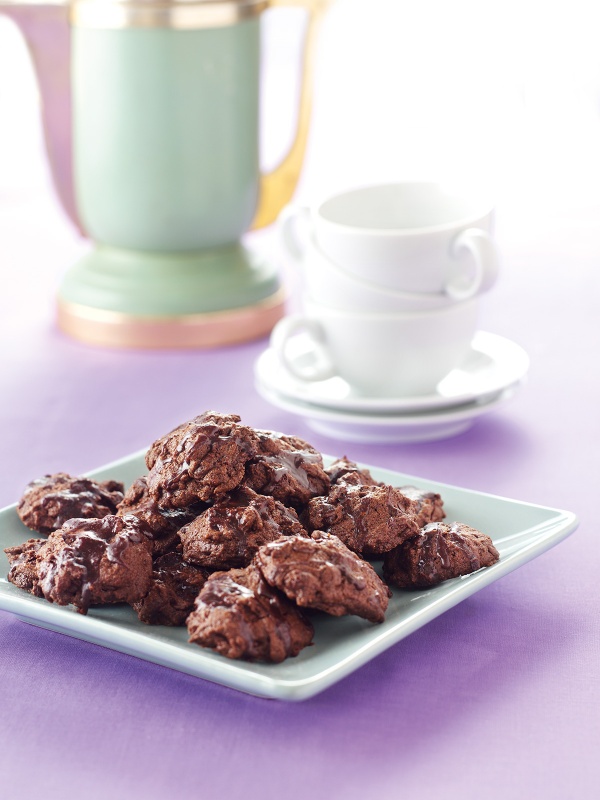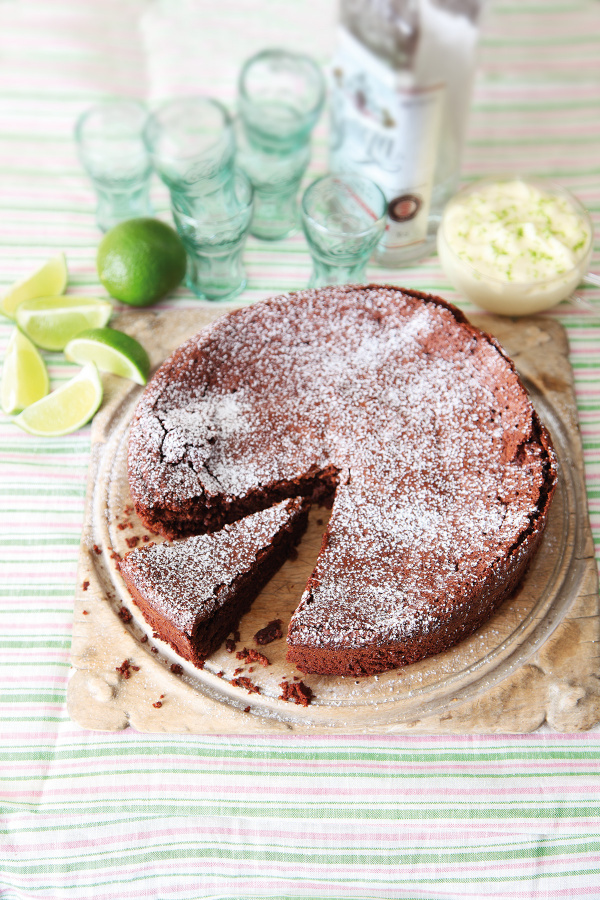Salty Sweet Lime Crisp Sandwiches
by Natalie Paull, featured in Beatrix Bakes Another Slice Published by QuadrilleIntroduction
This cookie tastes like a narcissistic chorus line of citrus, salt and sugar vying for the lime (insert soft eye-roll) light. Let them duke it out and enjoy the full-tilt sherbetty tongue tingle. I like just a whisper of the frosting so the sandwich is more cookie than cream, but there’s some extra frosting if you prefer the converse ratio. This is a great recipe to use up those limes that have ripened to yellow — their humble acidity brings a touch of class to the show. The dough is counterintuitive to mainstream cookie techniques, but it gives these a buttery brittle snap; it’s a cinch to roll while cold and they hold great shape when baked.
This cookie tastes like a narcissistic chorus line of citrus, salt and sugar vying for the lime (insert soft eye-roll) light. Let them duke it out and enjoy the full-tilt sherbetty tongue tingle. I like just a whisper of the frosting so the sandwich is more cookie than cream, but there’s some extra frosting if you prefer the converse ratio. This is a great recipe to use up those limes that have ripened to yellow — their humble acidity brings a touch of class to the show. The dough is counterintuitive to mainstream cookie techniques, but it gives these a buttery brittle snap; it’s a cinch to roll while cold and they hold great shape when baked.

Share or save this
Ingredients
Makes: Around 10 filled sandwiches
LIME COOKIES
- 100 grams unsalted butter
- 30 grams good extra virgin olive oil
- zest of 1 lime (reserve juice for filling, below)
- 200 grams plain flour
- 2 grams fine sea salt
- 3 grams baking powder
- 50 grams eggs (approx. 1 egg)
- 80 grams caster sugar
- cooking oil spray
SWEET SALTY SPRINKLE
- 30 grams caster sugar
- 1 gram sea salt flakes (lightly crushed)
LIME FROSTING FILLING
- zest and juice of 1 lime (plus juice from lime used in dough, see above)
- 240 grams icing sugar
- 60 grams unsalted butter (very soft and squidgy)
- 15 grams good extra virgin olive oil
- 1 gram sea salt flakes
LIME COOKIES
- 3½ ounces unsalted butter
- 1 ounce good extra virgin olive oil
- zest of 1 lime (reserve juice for filling, below)
- 7 ounces all-purpose flour
- ¼ teaspoon fine sea salt
- ½ teaspoon baking powder
- 1¾ ounces eggs (approx. 1 egg)
- 2¾ ounces superfine sugar
- cooking oil spray
SWEET SALTY SPRINKLE
- 1 ounce superfine sugar
- 1 gram sea salt flakes (lightly crushed)
LIME FROSTING FILLING
- zest and juice of 1 lime (plus juice from lime used in dough, see above)
- 8½ ounces confectioners' sugar
- 2 ounces unsalted butter (very soft and squidgy)
- ½ ounce good extra virgin olive oil
- 1 gram sea salt flakes
Method
Salty Sweet Lime Crisp Sandwiches is a guest recipe by Natalie Paull so we are not able to answer questions regarding this recipe
- Start the dough: melt the butter (microwave or stovetop), then add the oil and cool completely — warm butter will make a greasy, seized dough. Add the lime zest, then set aside.
- Weigh the flour, salt and baking powder together into a small bowl. Stir with a whisk to combine, then set aside. In a large bowl, hand whisk the egg and sugar energetically for around 30 seconds until it just turns a shade paler yellow. No need to whip in lots of air. Whisk in the cool butter/oil/zest. Switch to a stiff plastic spatula and stir in the dry ingredients until the mixture forms a thick, mashed potato–like paste and the bowl has clean sides. Scrape into a piece of plastic wrap and chill for a minimum of 3 hours, or ideally overnight, before rolling out.
- Preheat the oven to 130°C (265°F). Line a shallow baking tray with cooking oil spray and baking paper. Give the dough, still wrapped, a few firm pushes against the work surface to encourage it to yield to the rolling pin. Unwrap the dough and place onto a flour-dusted surface, then dust the top of the dough with flour.
- This dough gets pliable quickly so roll from fridge cold, keeping the work surface well dusted, and do short hard rolls, rotating often until the dough starts to really grow. Roll to around 30 cm × 30 cm (12 in × 12 in) — around 3 mm (1/8 in) thick. Stamp out as many cookies as you can with a 7 cm (2¾ in) fluted square cutter, making sure you stamp hard to cut through any zesty bits lurking along the cut lines. Lift the cut cookies onto the baking tray, only slightly apart, as they won’t spread at all. Collect the scraps, squeeze together lightly and roll again. Try to avoid rolling a third time, but if you have to in order to get all twenty, do it. No need to chill again — these can go straight in the oven to bake for about 40–50 minutes until firmly set (when you can easily lift one up). They should look dry, not gummy, and the colour will be a honey gold hue.
- Remove from the oven, make the sweet salty sprinkle by mixing the sugar and salt in a small bowl and dust over the cookie tops while they are hot. Place the trays on a wire rack to cool completely for 10–15 minutes before filling, or cool in the oven overnight. If the oven temperature is any higher or you dust the raw dough with the sprinkle pre-bake, the cookies will start to contract and dome, making them a bit funny looking, and tricky to fill without overloading the curved space with excess frosting. If they are still warm, flatten with a heavy tray on top. The edges may crack a little.
- Make the lime frosting filling while the cookies are baking and cooling. Zest the second lime and set aside. Zested citrus (or ‘nude’, as I call it) deteriorates quickly. So I concentrate the juice and use it to pep up creams, frostings and custards without adding excessive liquid. Using a microwave is the BEST method of doing this — it retains the juice colour and you can see the level of reduction through a clear plastic container. Choose an oversized plastic container, as the juice will bubble a lot. Zap the strained fruit juice on High (100%) heat bursts of 2–3 minutes until the target amount of 30g/ml (1 oz) is reached. This method is also nifty, as it means you can keep putting the plastic bucket on the scales to check how far it has reduced. Just don’t zero/tare it off in between zaps. If you don’t own a microwave, reduce your juice using a saucepan — just be wary not to let the flames lick up the side, as this will brown and discolour the juice. If you over-reduce and the juice becomes a too-sticky syrup, add a little water (that’s what has evaporated) or extra juice to make it flow. If you burn the juice, add a little extra water — it will still have the zest. Place the reduced lime juice into the bowl of a stand mixer and add the zest and remaining ingredients on top. Beat with the paddle attachment on speed 4 (below medium) for 10 minutes until the frosting is fluffy, pale and ultra-creamy. Scrape the bowl sides down twice. The frosting should hold its shape and not be melty or slack. If the frosting does slump, take the bowl and paddle off the mixer and chill for 30 minutes. Return to the mixer and keep beating until cool and fluffy.
- To fill the cookies, swipe a heaped teaspoonful of frosting on one cookie, smooth out evenly with an offset spatula, then swipe the spatula against the edges of the cookie to make a sharp finish. Sandwich the top on and give it a tiny squeeze together. Run your pinky finger around the sides to neaten up any oozy bits. For cakeshop pro filling, scrape the frosting into a piping (icing) bag with a small sized tip (#3). Lay half the cookies, top side down, on a clean tea towel (dish towel) to prevent slipping. Pipe an outline of frosting, then fill it in. Sandwich the top cookie on.
- Start the dough: melt the butter (microwave or stovetop), then add the oil and cool completely — warm butter will make a greasy, seized dough. Add the lime zest, then set aside.
- Weigh the flour, salt and baking powder together into a small bowl. Stir with a whisk to combine, then set aside. In a large bowl, hand whisk the egg and sugar energetically for around 30 seconds until it just turns a shade paler yellow. No need to whip in lots of air. Whisk in the cool butter/oil/zest. Switch to a stiff plastic spatula and stir in the dry ingredients until the mixture forms a thick, mashed potato–like paste and the bowl has clean sides. Scrape into a piece of plastic wrap and chill for a minimum of 3 hours, or ideally overnight, before rolling out.
- Preheat the oven to 130°C (265°F). Line a shallow baking tray with cooking oil spray and baking paper. Give the dough, still wrapped, a few firm pushes against the work surface to encourage it to yield to the rolling pin. Unwrap the dough and place onto a flour-dusted surface, then dust the top of the dough with flour.
- This dough gets pliable quickly so roll from fridge cold, keeping the work surface well dusted, and do short hard rolls, rotating often until the dough starts to really grow. Roll to around 30 cm × 30 cm (12 in × 12 in) — around 3 mm (1/8 in) thick. Stamp out as many cookies as you can with a 7 cm (2¾ in) fluted square cutter, making sure you stamp hard to cut through any zesty bits lurking along the cut lines. Lift the cut cookies onto the baking tray, only slightly apart, as they won’t spread at all. Collect the scraps, squeeze together lightly and roll again. Try to avoid rolling a third time, but if you have to in order to get all twenty, do it. No need to chill again — these can go straight in the oven to bake for about 40–50 minutes until firmly set (when you can easily lift one up). They should look dry, not gummy, and the colour will be a honey gold hue.
- Remove from the oven, make the sweet salty sprinkle by mixing the sugar and salt in a small bowl and dust over the cookie tops while they are hot. Place the trays on a wire rack to cool completely for 10–15 minutes before filling, or cool in the oven overnight. If the oven temperature is any higher or you dust the raw dough with the sprinkle pre-bake, the cookies will start to contract and dome, making them a bit funny looking, and tricky to fill without overloading the curved space with excess frosting. If they are still warm, flatten with a heavy tray on top. The edges may crack a little.
- Make the lime frosting filling while the cookies are baking and cooling. Zest the second lime and set aside. Zested citrus (or ‘nude’, as I call it) deteriorates quickly. So I concentrate the juice and use it to pep up creams, frostings and custards without adding excessive liquid. Using a microwave is the BEST method of doing this — it retains the juice colour and you can see the level of reduction through a clear plastic container. Choose an oversized plastic container, as the juice will bubble a lot. Zap the strained fruit juice on High (100%) heat bursts of 2–3 minutes until the target amount of 30g/ml (1 oz) is reached. This method is also nifty, as it means you can keep putting the plastic bucket on the scales to check how far it has reduced. Just don’t zero/tare it off in between zaps. If you don’t own a microwave, reduce your juice using a saucepan — just be wary not to let the flames lick up the side, as this will brown and discolour the juice. If you over-reduce and the juice becomes a too-sticky syrup, add a little water (that’s what has evaporated) or extra juice to make it flow. If you burn the juice, add a little extra water — it will still have the zest. Place the reduced lime juice into the bowl of a stand mixer and add the zest and remaining ingredients on top. Beat with the paddle attachment on speed 4 (below medium) for 10 minutes until the frosting is fluffy, pale and ultra-creamy. Scrape the bowl sides down twice. The frosting should hold its shape and not be melty or slack. If the frosting does slump, take the bowl and paddle off the mixer and chill for 30 minutes. Return to the mixer and keep beating until cool and fluffy.
- To fill the cookies, swipe a heaped teaspoonful of frosting on one cookie, smooth out evenly with an offset spatula, then swipe the spatula against the edges of the cookie to make a sharp finish. Sandwich the top on and give it a tiny squeeze together. Run your pinky finger around the sides to neaten up any oozy bits. For cakeshop pro filling, scrape the frosting into a piping (icing) bag with a small sized tip (#3). Lay half the cookies, top side down, on a clean tea towel (dish towel) to prevent slipping. Pipe an outline of frosting, then fill it in. Sandwich the top cookie on.
Additional Information
Takes:
Make the dough the day before. Then 1½ hours to roll, bake and fill.
Keeps:
Raw dough will keep for 2 days. Baked and filled up to 2 weeks, airtight and chilled. They soften a little over time.
Takes:
Make the dough the day before. Then 1½ hours to roll, bake and fill.
Keeps:
Raw dough will keep for 2 days. Baked and filled up to 2 weeks, airtight and chilled. They soften a little over time.






Tell us what you think
Thank you {% member.data['first-name'] %}.
Explore more recipesYour comment has been submitted.